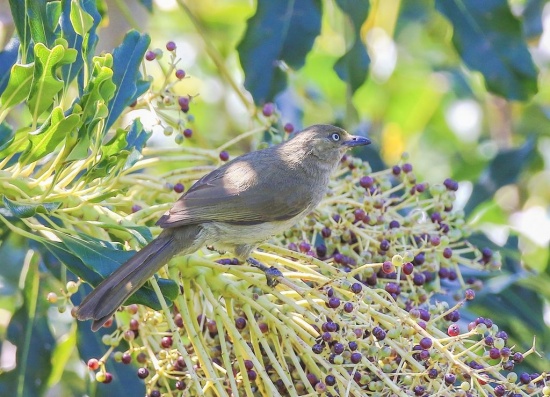(→References: Updated and expanded) |
(→Behaviour: Expanded with Action, Breeding, Voice & Movements.) |
||
| Line 25: | Line 25: | ||
Thick coastal bush, evergreen forest and dry shrubland and wooded gardens. | Thick coastal bush, evergreen forest and dry shrubland and wooded gardens. | ||
==Behaviour== | ==Behaviour== | ||
| + | ====Action==== | ||
| + | They tend to sit still blending into the vegetation. | ||
====Diet==== | ====Diet==== | ||
The diet consists mostly of berries and other fruit, with the addition of insects and small snails. | The diet consists mostly of berries and other fruit, with the addition of insects and small snails. | ||
| + | ====Breeding==== | ||
| + | '''Courtship''' display includes head bobbing, raised head and nape feathers and wing quivering by both partners. Monogamous. | ||
| + | '''Nest''' built by female is rather flimsy, thin-walled, shallow cup made of dry grass, twigs, rootlets, lichen and lined with finer plant fibers and sometimes hair. '''Clutch''' is 1-3 eggs, usually two; incubation by female. | ||
| + | ====Vocalisation==== | ||
| + | This species sings loudly and persistently from high in the canopy but can be maddeningly difficult to see. | ||
| + | '*''Call''' a penetrating rising "willie." | ||
| + | '*''Song''' given throughout the year is is a distinctive piercing "weeeweee" followed by a liquid chortle. | ||
| + | ====Movements==== | ||
| + | Sedentary. Flocks may wander locally in search of food. | ||
| + | |||
==Gallery== | ==Gallery== | ||
Click on photo for larger image | Click on photo for larger image | ||
Revision as of 11:11, 29 June 2018
- Andropadus importunus
Identification
15–17·5 cm (6-6¾ in)
- Dull grey olive-green plumage
- Paler underparts
- White iris
Sexes are similar
Juveniles: duller and have dark eyes
Distribution
Eastern Africa from Ethiopia to southern South Africa.
Taxonomy
Subspecies
Andropadus importunus has four subspecies:[1]
- A. i. insularis
- A. i. hypoxanthus
- Southern Tanzania to Malawi, Zambia, eastern Zimbabwe and Mozambique
- A. i. oleaginus
- Southern Mozambique, north-eastern KwaZulu-Natal and far north-eastern Limpopo Province (South Africa)
- A. i. importunus
- North-eastern, south-eastern and southern South Africa
Habitat
Thick coastal bush, evergreen forest and dry shrubland and wooded gardens.
Behaviour
Action
They tend to sit still blending into the vegetation.
Diet
The diet consists mostly of berries and other fruit, with the addition of insects and small snails.
Breeding
Courtship display includes head bobbing, raised head and nape feathers and wing quivering by both partners. Monogamous. Nest built by female is rather flimsy, thin-walled, shallow cup made of dry grass, twigs, rootlets, lichen and lined with finer plant fibers and sometimes hair. Clutch is 1-3 eggs, usually two; incubation by female.
Vocalisation
This species sings loudly and persistently from high in the canopy but can be maddeningly difficult to see. '*Call' a penetrating rising "willie." '*Song' given throughout the year is is a distinctive piercing "weeeweee" followed by a liquid chortle.
Movements
Sedentary. Flocks may wander locally in search of food.
Gallery
Click on photo for larger image
Photo by rudydbn
References
- Clements, J. F., T. S. Schulenberg, M. J. Iliff, D. Roberson, T. A. Fredericks, B. L. Sullivan, and C. L. Wood. 2017. The eBird/Clements checklist of birds of the world: v2017, with updates to August 2017. Downloaded from http://www.birds.cornell.edu/clementschecklist/download/
- Fishpool, L. & Tobias, J. (2018). Sombre Greenbul (Andropadus importunus). In: del Hoyo, J., Elliott, A., Sargatal, J., Christie, D.A. & de Juana, E. (eds.). Handbook of the Birds of the World Alive. Lynx Edicions, Barcelona. (retrieved from https://www.hbw.com/node/57973 on 25 June 2018).
- Sinclair, I., Hockey, P.A.R., and Arlott, N. (2005). The Larger Illustrated Guide to Birds of Southern Africa. Struik, Cape Town. ISBN 978-1775840992
- Wikipedia
Recommended Citation
- BirdForum Opus contributors. (2024) Sombre Greenbul. In: BirdForum, the forum for wild birds and birding. Retrieved 25 April 2024 from https://www.birdforum.net/opus/Sombre_Greenbul






